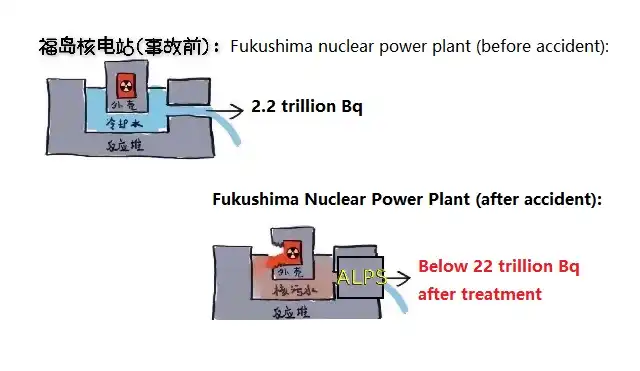Japan’s Discharge as “Radioactive Polluted Water” Rather Than “Nuclear Waste Water”
- EB Virus Could Be Infected by Kiss: A Hidden Threat Linked to Cancer
- The Silent Threat: How Gas Stoves Pollute Our Homes and Impact Health
- Paternal Microbiome Perturbations Impact Offspring Fitness
- New Report Casts Doubt on Maradona’s Cause of Death and Rocks Manslaughter Case
- Chinese academician unable to provide the exact source of liver transplants
- Early Biomarker for Multiple Sclerosis Development Identified Years in Advance
China Scholar Points Out: Japan’s Discharge as “Radioactive Polluted Water” Rather Than “Nuclear Waste Water”
- AstraZeneca Admits for the First Time that its COVID Vaccine Has Blood Clot Side Effects
- Was COVID virus leaked from the Chinese WIV lab?
- HIV Cure Research: New Study Links Viral DNA Levels to Spontaneous Control
- FDA has mandated a top-level black box warning for all marketed CAR-T therapies
- Can people with high blood pressure eat peanuts?
- What is the difference between dopamine and dobutamine?
- How long can the patient live after heart stent surgery?
China Scholar Points Out: Japan’s Discharge as “Radioactive Polluted Water” Rather Than “Nuclear Waste Water”
On August 24, 2023, local time, the Japanese government officially began discharging contaminated water from the Fukushima Daiichi nuclear power plant into the sea amid opposition.
As per the plan, Tokyo Electric Power Company (TEPCO) will discharge around 460 tons of contaminated water daily for the next 17 days, gradually increasing the amount afterward. Currently, approximately 1.34 million tons of contaminated water are stored within the Fukushima Daiichi nuclear power plant.

“Meeting Standards for Discharge?” or “Detoxifying into the Ocean?”
The Japanese officials strongly assert in their statement that the discharged water is “treated clean water.” From a scientific perspective, experts and environmental organizations have significant concerns about the data provided by TEPCO regarding the treatment of radioactive contaminated water and other related matters.
Firstly, the “radioactive contaminated water” being discharged by Japan this time is not equivalent to the “nuclear waste water” released during the normal operation of nuclear reactors. These two have fundamental differences and exhibit distinct impacts on the marine environment.
Professor Mei Hong from the Law School of the Ocean University of China points out in a written article that Japan’s plan to discharge into the ocean is not nuclear waste water, meaning it’s not the water released during the regular operation of nuclear reactors, but rather nuclear polluted/contaminated/radioactive water.
This refers to highly hazardous pollutants generated due to direct contact between nuclear fuel and water resulting from nuclear accidents and similar causes.
The polluted water being discharged by Japan this time originated from the severe damage suffered by the Fukushima nuclear power plant due to the earthquake and tsunami on March 11, 2011, resulting in the complete meltdown of three reactor cores.
At that time, the approach involved manually extracting seawater and pouring it onto these highly heated melted cores to cool them down, which produced over 200 types of highly toxic radioactive isotopes harmful to life forms.
In contrast, nuclear waste water refers to one of the nuclear waste materials generated during the regular operation of nuclear power plants. Considerable research has been conducted on this with relatively mature technology, allowing for discharge while adhering to strict standards. Research suggests that the discharge standards for nuclear waste water are not applicable to the discharge of nuclear polluted water.
Furthermore, Japan’s official reports have consistently attempted to blur the distinction between “radioactive polluted water” and “nuclear waste water.”
They also reference the standards and requirements related to nuclear waste water and even cite instances of countries like France discharging nuclear waste water into the sea, trying to establish that ocean discharge of treated nuclear polluted water has become an international norm or even an international practice.
However, this standpoint doesn’t hold up. Firstly, the nuclear waste water of France and other countries is not the same concept as Japan’s nuclear polluted water. Secondly, the disposal of waste doesn’t align with the fundamental principles of international environmental law, and the behavior of discharging diluted waste, even if practiced by some nations, doesn’t constitute an international norm.
Secondly, in Japan’s plan for discharging nuclear polluted water, the Advanced Liquid Processing System (ALPS) is crucial. The Japanese side firmly maintains that the nuclear polluted water treated by ALPS is “treated water” and meets the standards for discharge. However, the reality is different.
First, many radioactive isotopes in the nuclear polluted water lack effective treatment methods.
The Fukushima nuclear polluted water contains over 60 types of radioactive isotopes, such as tritium, carbon-14, iodine-129, etc. Many of these isotopes lack effective treatment methods, yet Japan has consistently attempted to mislead by focusing solely on the “problem of tritium.”
An investigation report titled “Crisis of TEPCO Fukushima Daiichi Nuclear Power Station Polluted Water” by an international environmental organization in 2020 pointed out that ALPS cannot remove radioactive tritium and carbon-14, nor can it completely eliminate other radioactive isotopes such as strontium-90, iodine-129, and cobalt-60.
Second, the radioactive isotopes in the nuclear polluted water impact human health.
The Japanese side claims that after dilution in seawater, the tritium concentration will be reduced to less than one-fortieth of Japan’s regulatory standards. However, dilution does not reduce the overall radioactive dose from the discharge of nuclear polluted water.
Gao Zhiguo, President of the China Society of Ocean Law and former judge of the International Tribunal for the Law of the Sea, stated that among these radioactive isotopes, tritium might not be the most dangerous once they enter the marine ecosystem. Carbon-14 and iodine-129 pose the greatest threats to human health and marine life. Carbon-14 has a half-life of over 5000 years, and iodine-129 has an even longer half-life. Carbon-14 can accumulate in marine organisms, particularly in fish, with concentrations potentially 50 times that of tritium.
Third, the scope of the impact of nuclear polluted water is global.
The German marine science research institution indicates that the coastal waters off Fukushima possess the world’s strongest currents. Within 57 days from the start of the discharge, radioactive substances will spread to a large portion of the Pacific Ocean. After three years, the Pacific Ocean on the other side, affecting the United States and Canada, will experience the effects of nuclear pollution, and after ten years, it will spread to oceans worldwide.
Inescapable International Responsibility
Professor Mei Hong of the Law School at the Ocean University of China points out in a relevant paper that Japan’s discharge of nuclear wastewater constitutes a risk to the marine environment.
If this uncontrolled development of marine environmental risk continues, it will lead to a trend of ecological damage to the ocean environment. In this sense, opposing Japan’s discharge of nuclear wastewater is a global environmental issue.
The United Nations Convention on the Law of the Sea requires all countries to take all necessary measures to ensure that their activities under their jurisdiction or control do not cause harm to the environment of other countries and beyond their jurisdiction.
However, in the past two years, the Japanese government’s statements that the treated nuclear wastewater discharged into the ocean will not cause environmental pollution lack scientific basis and are therefore not credible.
Based on existing facts and the conclusions of relevant research, it can be presumed that the discharge of millions of tons of nuclear wastewater into the ocean will have serious damaging consequences.
Although these damaging consequences have not yet occurred, due to the long-term, severe, and irreversible nature of damage to the marine ecosystem, the international community cannot wait for the actions to be implemented and the harmful consequences to occur before taking action.
Instead, it should promptly prevent the discharge of nuclear wastewater into the ocean, strengthen negotiations and cooperation, and jointly discuss safer and more reasonable methods for handling nuclear wastewater.
Japan ratified the United Nations Convention on the Law of the Sea on June 20, 1996, and as such, it should follow the convention’s obligations to prevent marine environmental risks.
Violating international legal obligations by discharging nuclear wastewater into the sea will inevitably lead to cross-border environmental damage liability.
Dispersing the ongoing damage caused by nuclear wastewater to the marine environment is a legal responsibility that the Japanese government and Tokyo Electric Power Company cannot escape.
The Future of Marine Environmental Risk Prevention
The Ministry of Ecology and Environment (National Nuclear Safety Administration) stated on the 24th that Japan’s forced release of contaminated water from the Fukushima nuclear plant prioritizes its own interests over the long-term well-being of all humanity, showing extreme selfishness and irresponsibility.
The Ministry of Ecology and Environment will attach great importance to the issue of Japan’s discharge of contaminated water from Fukushima and is currently organizing marine radiation environmental monitoring in the areas under China’s jurisdiction for the year 2023, focusing on monitoring key areas and covering jurisdictional waters.
The Ministry will continue to strengthen relevant monitoring work, track and assess the potential impact of Fukushima’s discharge of contaminated water on China’s marine radiation environment in a timely manner, and effectively safeguard China’s national interests and the health of its people.
The head of the Import and Export Food Safety Bureau of the General Administration of Customs of China stated that the General Administration of Customs attaches great importance to the radioactive contamination risk posed by Japanese food and agricultural products imported to China as a result of Japan’s actions.
In accordance with relevant Chinese laws and regulations, as well as the provisions of the World Trade Organization’s Agreement on the Application of Sanitary and Phytosanitary Measures, the General Administration of Customs has decided to take emergency measures to fully suspend the import of aquatic products originating from Japan (including edible aquatic animals) from August 24, 2023, onwards.
Meanwhile, at the routine press conference held on the same day, a spokesperson for the Ministry of Commerce, Shu Jueteng, strongly opposed and condemned Japan’s unilateral and forced discharge of contaminated water from Fukushima, describing it as an act that disregards international public interests.
The discharge of nuclear wastewater by Japan is a global environmental issue that cannot be ignored in the world’s risk society. Environmental issues are not limited to the interests of specific regions or countries but are about maintaining the stability and health of the entire global ecosystem.
The international community is encouraged to take coordinated action to ensure that human actions do not cause irreversible harm to the ecological balance and sustainable development of the Earth.
Related news from ChinaDaily
“Difference Between ‘Nuclear Contaminated Water’ and ‘Nuclear Wastewater’ Must Not Be Confused”
The Japanese government and Tokyo Electric Power Company (TEPCO) insist in official documents that the discharged water is “treated nuclear wastewater,” while the majority of countries and international organizations refer to it as “nuclear contaminated water.” It’s essential to understand the distinction between these terms.
Nuclear wastewater refers to the water generated during the normal operation of a nuclear power plant, such as cooling water from the reactor, which does not come into direct contact with the nuclear fuel or radioactive materials within the reactor core. After treatment, it can be safely discharged through pipelines.
In contrast, nuclear contaminated water results from a nuclear accident where the protective shell of the reactor is breached, allowing cooling water to directly contact radioactive substances in the reactor, becoming highly radioactive in the process. Nuclear contaminated water contains dozens of radioactive materials like plutonium and cesium, posing severe threats to both humans and the environment, leading to cancer, mutations, and birth defects.
Some of these substances have long half-lives, for instance, iodine-129 with a half-life of 15.7 million years, and carbon-14 with a half-life of 5,730 years, making them challenging to remove from water.
The Fukushima Daiichi nuclear power plant experienced a significant accident in 2011, resulting in typical “nuclear contaminated water.” The Japanese authorities equating it with the wastewater from normal plant operations appears to be an attempt to obfuscate the situation.
Japan’s handling of nuclear contaminated water through the ALPS system is problematic and unreliable
Japan employs the multi-nuclide removal system ALPS to treat nuclear contaminated water and claims that the impact of the treated water on people and the environment can be negligible. However, such assertions fail to dispel public doubts.
ALPS was hastily put into trial operation in March 2013, with no prior international precedents and questionable technical maturity and safety. Over the years, ALPS has faced a series of issues: in 2016, the system had four instances of leaks; in 2018, it was revealed that radioactive substances like strontium in the “treated water” exceeded limits; in 2021, nearly half of the filters in the exhaust ports of ALPS, used for adsorbing radioactive materials, were found damaged, despite being replaced just two years prior.
Since the introduction of ALPS, the Japanese authorities have referred to the treated nuclear contaminated water simply as “treated water.”
Currently, only about one-third of the more than 1.3 million cubic meters of water stored at the Fukushima Daiichi nuclear power plant meet TEPCO’s definition of “treated water,” with roughly 70% falling under the category of “process water” due to not meeting the required standards.
Data related to the handling of Japan’s nuclear contaminated water is tainted and untrustworthy
The entity responsible for implementing the Fukushima nuclear leakage accident and discharging nuclear contaminated water into the sea is Tokyo Electric Power Company (TEPCO).
This company has a history of misconduct and concealing safety hazards both before and after the Fukushima nuclear accident. When the accident occurred at the Fukushima nuclear power plant, the backup cooling system for the reactor core malfunctioned, a known issue that TEPCO had previously covered up to pass safety inspections.
Three days after the Fukushima nuclear accident in March 2011, TEPCO had data that indicated core meltdowns in Units 1 to 3, yet it continued to downplay the situation as “core damage” for two months before finally admitting to the meltdowns.
TEPCO once claimed that no new nuclear contaminated water had been released into the ocean after June 2011, but it wasn’t until a series of leaks in 2013 that they admitted to high-concentration nuclear contaminated water being discharged into the sea.
In October 2022, TEPCO was exposed for misleading visitors by using faulty radiation detectors to prove the safety of “ALPS treated water.” Falsifying data and concealing risks have been a consistent choice for TEPCO. Can we trust the data they provide, claiming that the “treated water is safe”?
Japan Nuclear Wastewater Reaches West Coast of North Pacific in 1200 Days!
How serious is the harm of Fukushima Nuclear Sewage ?
Nuclear contaminated water: Japanese government paid bribes and corrected the IAEA report
China Scholar Points Out: Japan’s Discharge as “Radioactive Polluted Water” Rather Than “Nuclear Waste Water”
Reference:
(source:internet, reference only)
Disclaimer of medicaltrend.org
Important Note: The information provided is for informational purposes only and should not be considered as medical advice.



